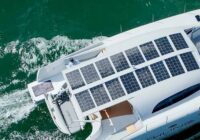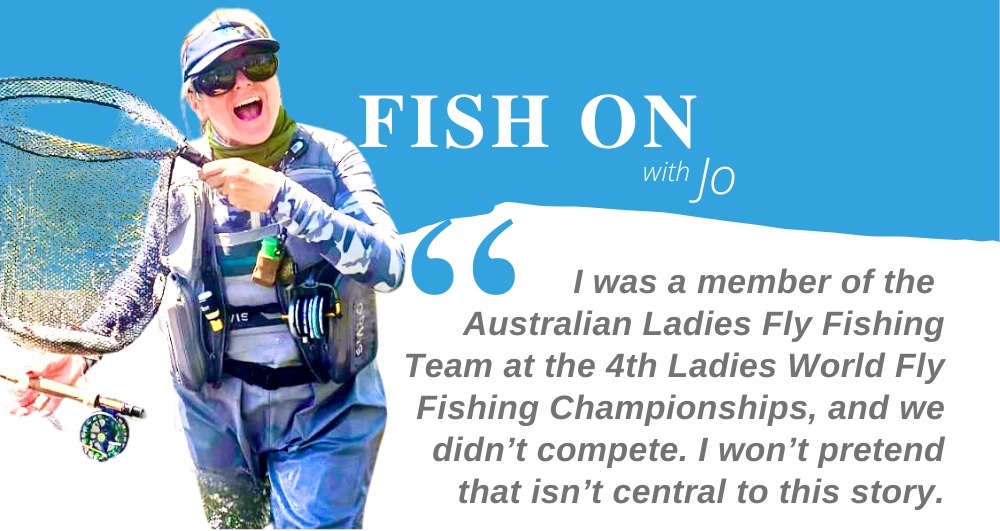
The Australia Ladies Fly Fishing Team went to the U.S. to compete — and didn’t. That sentence sits heavy for a short moment, then ruptures. Four days out from lines-in we were sent a complex waiver with mixed signals about whether it was mandatory. Lining up to take our seats on the sector buses on Day One we were told, plainly: no waiver, no competing. What followed was a blur of meetings for the Australian team management, and, most critically, the discovery that the organisers had not taken out accident-injury insurance the way we expected. Tip in seriously hazardous access at key venues and the realisation that pressing on would have been unsafe and financially irresponsible, and the path forward was clear — even if the fallout would be loud.
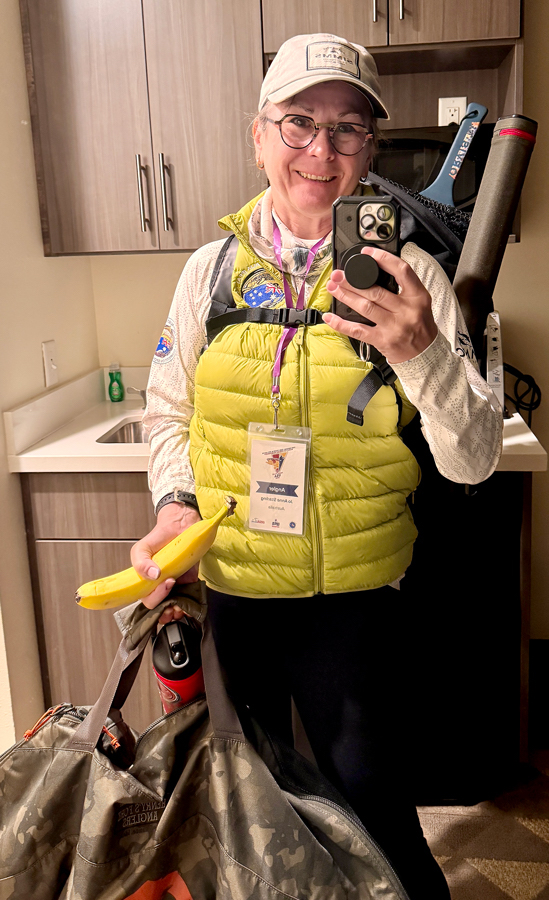
Ready, willing, able, EXCITED! Jo Starling takes a quick selfie to commemorate her first day of competing for her country.
There are still processes in motion, so the why and the politics stay measured here. That part of the story is covered in a little more detail in my field report, for those who want the chronology. What I want to spend most of this editorial on is what happened next, and what the water gave back when we decided not to accept the lemons served.
The day that started in disbelief — stopped from boarding buses, staring at the legacy we’d planned to defend, the 2024 bronze medal we’d come to build on — ended in a different conversation. We were here. The mid-western landscape no longer locked beyond Championship sectors. The randomly selected beats were closed to us, so we opened everything else. That pivot, shared quietly over tired shoulders and a few tears, was the hinge. By choosing to explore rather than retreat, we turned a crushing blow into something that feels more like momentum.
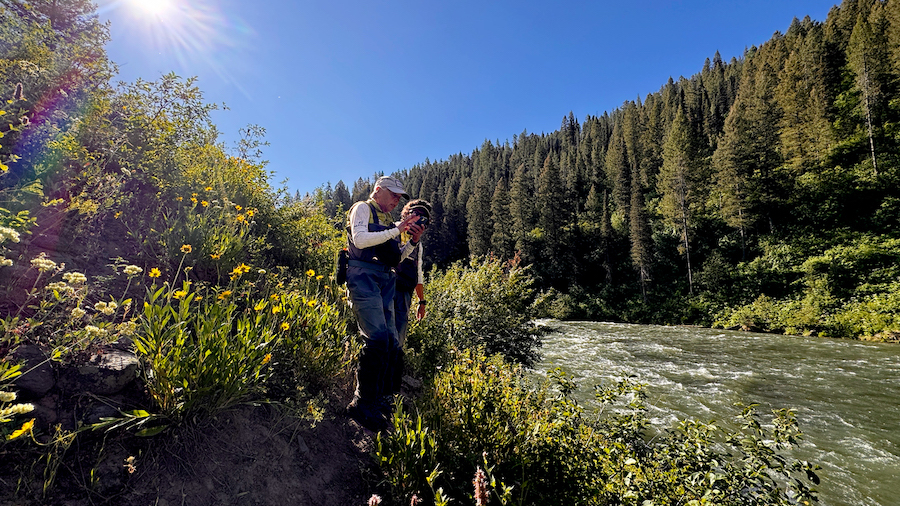
Australian team caption, Karen Brooks works with team mate Di Richards to identify beats on the Snake River during preparation. Note the lack of rods — competitors are not permitted to pre-fish actual beats.
The rivers didn’t ask for justification. They just showed up with the kind of pragmatism that strips away excuses. Granite cliffs and pine-columned ravines held their own magical, soft light with beams pirouetting in the seams, oxygen so rich it felt like someone had turned the dial on clarity. Everything stood out: every insect, every ripple, every shadow of a seam where a trout might hold. If my Makos had voices, they would’ve been humming. This is what making lemonade looks like. I reckon I was literally fishing in it.
Yet even in this fishers fairytale, our exclusion from the Worlds was a constant prickle with about as much punctuation as the sudden appearance of a Cheezel-like mouth of a carp slurping the surface of that pristine scene (that didn’t happen, thankfully!) — You don’t want it in the frame, yet there it is, impossible not to acknowledge. So here’s my short assessment: I’m proud of the call the team made. I’d make it again, even more confidently with what I know now having had the time to confirm the implications. But it’s the backdrop, not the whole picture. With that cleared and handled, what came after is the gold we’re bottling, and I’ll share a few of my favourite epiphanies with you here…
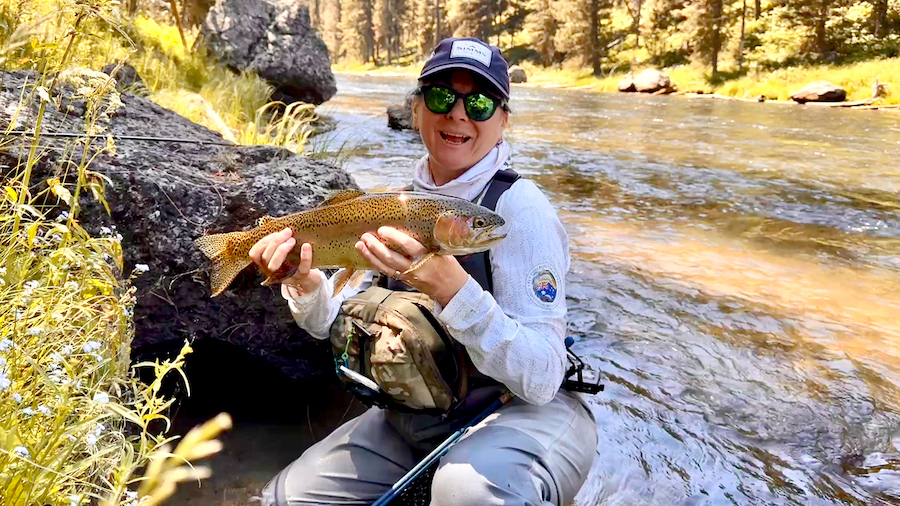
Proof is in the pudding: Lack of bites is likely an indication of lack of fish more than lack of ability.
Lesson one: move!
For two years I’ve been working on my euro-nymphing skills here in Australia, grinding long quiet stretches and assuming the lack of success was a personal shortcoming. The water in the States gave me a more uplifting answer. Same technique, different feedback: the drifts were clean, the fish were there, the rod bent. It was a simple, sharp reframing — if your presentations are sound and nothing’s happening, it’s not always you. Move. That’s not defeat. It’s efficiency. That insight alone will change how I push through frustration and how I coach others to stop overworking dead water and start reading the signposts.
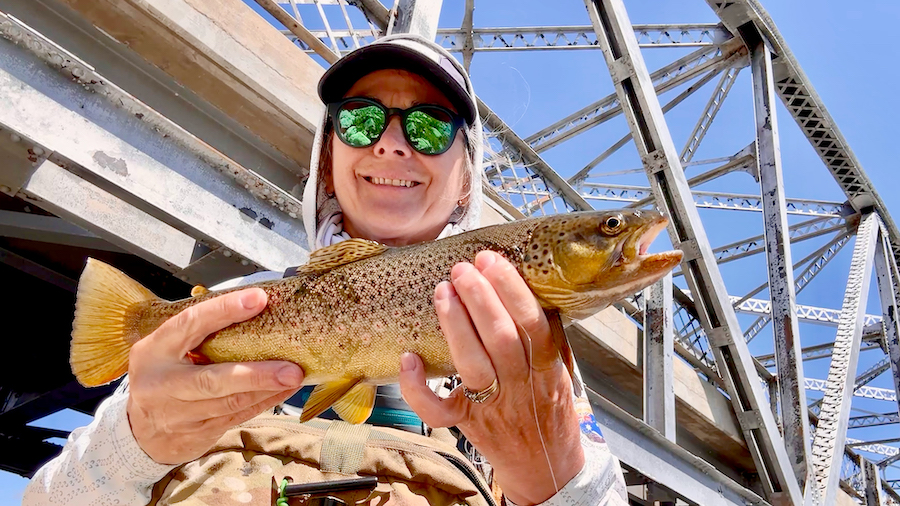
Pulled from a river with at least twenty other anglers in view, this brown proved to Jo that high fish density compensates for high fisher density.
A culture of abundance, not competition.
The American people on the ground are nothing like the image projected by their leadership. It was quite the contrast to our Australian fishing culture. Every single access point on a river in the states we fished — Idaho, Wyoming, Montana — boasted parked cars, regardless of the day of the week. There did not seem to be “a weekend throng” or “a quieter mid-week opportunity.” Fishing simply attracted “the throng,” but it was a polite, friendly, engaging throng.
The first time we experienced that culture shock was on the Madison River at Raynolds Pass. Anyone reading this will relate to my trepidation upon arriving after hours on the road to discover a half-filled carpark of oversized trucks. There was a moment of serious consideration — should we try the next spot? But then commonsense kicked in… they’re all like this! Getting to the water’s edge prompted even more facial collapse. Wader-clad blokes stretched like a fishing emu parade along the full length of the Madison — as far as the eye could see. There would have been 20–30 metres between each. I recall standing by a bush, feeling disappointed, lifting my eyes to take in the view as my compensation. OMG! Those vistas!!!
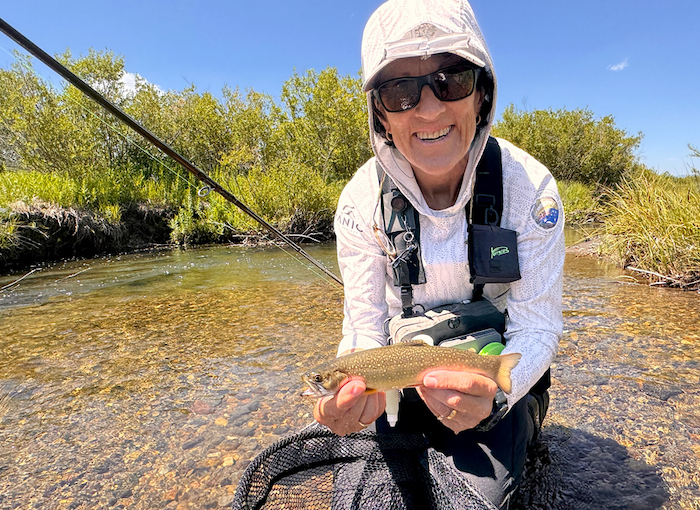
Red Rock Creek in Montana is spectacular — a clear, meandering, shallow waterway with deeper pools on every bend. We followed innumerable anglers and their dogs, yet still managed to pull fish after fish after fish! Here, Di Richards presents a gorgeous brook trout for our pleasure.
Then a friendly male voice pulled me back to the moment: “Jump in,” he invited. My eyes snapped back to find him smiling and indicating to a spot 10 metres upstream from him. “There’s plenty of water.”
Tailgate chats were also part of the scene. Locals quizzed us about fishing back home and shared their favourite flies — both conventional and invented — for whichever waterway we were approaching.
I ask you: can you imagine this ever happening here in Oz? This is not a criticism… more an insight: Such difference isn’t about a lesser culture; it’s about lesser opportunities. The topic became a philosophical conversation in our hired Dodge Suburban on the drive home. We realised that when there are that many fish per stretch of water, anglers can afford to invite each other in. Here in Oz, a honey hole is so easily depleted that we tend to guard it like a rabid dog.
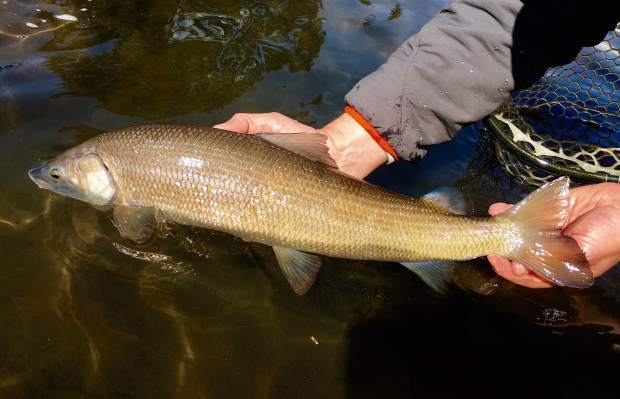
Apparently, this is a whitefish. Jo cannot confirm, as she never got to see hers!
photo by Jack Reis. www.postindependent.com/sports/outdoors/whitefish-a-key-indicator-and-fun-to-snag-too/
“That’s not Snowflake!”
Have you ever watched Ace Ventura, Pet Detective? If you have, you’ll giggle at my Snowflake moment…
The peculiarities between our trout species here in Australia hold true internationally too—browns hanging to structure, rainbows roaming free—but what surprised me was how much more belligerent some of the U.S. versions could be. Take whitefish, for example. I’d lazily filed them away in my head as “whitebait” equivalents—ultimate ignorance. How did I realise my mistake?
I was working a plan: get my nymph to drop cleanly through the column and pass deep behind a boulder nearly as tall as me, with the raging torrent patiently sculpting its surface. I figured a big brown might be sitting down there. The payoff was instant. The indicator didn’t twitch; it lurched. I lifted. The line yanked. The rod buckled. My eyebrows ended up somewhere in the forest behind me. “THAT’S NOT SNOWFLAKE!”
Taken completely by surprise, I lost that battle—along with everything up to my fly line. I’ll own it: I hadn’t re-tied my indicator in too long, so that lesson arrived on a very rustic platter. What I’d been wrestling was a whitefish. Incredibly heavy and powerful… and not white at all. I kept coming back to that spot, determined to win, but the fish were big and the water unforgiving, and my skills weren’t quite there. What changed each time was that I lost less gear and gained a proper, earned respect for the species!

Di Richards was an enormous support and mentor for Jo, in so many ways. Here, she hoists the rainbow that provided Jo and opportunity to “give back”.
Real-time coaching that matters.
Whilst I gleaned value from each member of the 2025 team, none came close to the camaraderie and coaching I enjoyed from my teammate, Di Richards from Tasmania. Sharing insights on everything from luggage logistics and gear organisation to practical lessons over the fly-tying vise and helping me improve my on-water skills, Di’s generosity and warmth — and the fact she was the rookie last year — was the buffer I didn’t know I needed this year. I gratefully acknowledge the little “D.R.” initials carved into the bottom right corner of my vastly improved fly-fishing confidence. We shared water, wonder and a lot of “wooohoooos.”
My favourite give-back moment was on the Henry’s Fork, at a stretch called Coffee Pot Rapids. Di had a lovely trout pinned in a tail-out and called across after battling it for some time: “Have you got any ideas, Jo? I’m struggling to land it in this current!” Pulling from years of fishing with Steve and from battling barra in tiger country, I offered a few adjustments — move to the bank, use rod angle to steer the fish out of the stronger current, gauge when to apply pressure and when to let it run, follow as needed and always know where your next opportunity for easing into softer water is — and watched it pay off. That gorgeous fish slid silkily into Di’s net. Seeing the result of that on-bank, real-time advice was genuinely rewarding and being there to capture Di’s beaming smile was pure gold — it could have powered a town!

The orange stitching in the net is a 20cm circle, helping to quickly identify a potential scorer for efficient decision making — a clever innovation shared by the team.
Setbacks, with the right lens, can refract into new insight. We didn’t get the competition we came for, but we came away with more usable gold than we expected. If that’s not making lemonade, I don’t know what is!
Until next time, FISH ON!

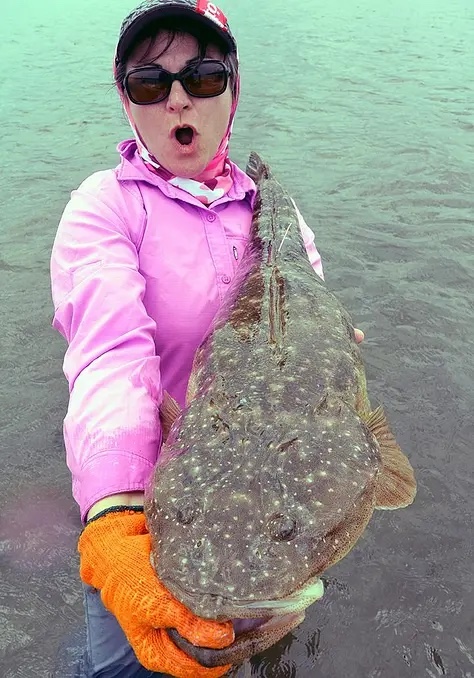
For three decades Jo has worked with businesses and personalities, helping them to promote themselves in one form or another, whether through graphic design, advertising, promotions or marketing.
She has owned a fishing rod for just as long, but it’s only been in this new century that it hasn’t been allowed to gather dust.
Jo is a passionate advocate for the sport of fishing and its promotion as a healthy lifestyle for women.
To find out more about Jo visit her website HERE
Or you can visit her Fishtopia Web site HERE or on the banner below.
Jo is also the founder and National President of the Women’s Recreational Fishing League (WRFL) Inc. The work they do is very important in balancing the participation ratios of fishing in Australia, thus making the collective voices of Aussie anglers more harmonious and powerful, as well as shoring up the economy of the sector. For more information visit their Website at womensrecfishingleague.org






